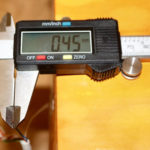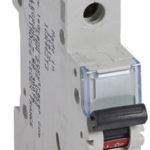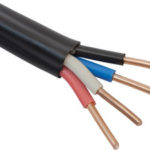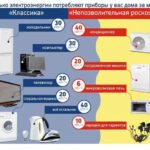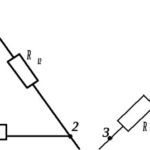When repairing and designing electrical equipment, it becomes necessary to choose the right wires. You can use a special calculator or reference book. But for this you need to know the load parameters and cable laying features.
Content
What is the calculation of the cable section for?
The following requirements are imposed on electrical networks:
- safety;
- reliability;
- economy.
If the selected wire cross-sectional area is small, then the current loads on cables and wires will be large, which will lead to overheating. As a result, an emergency situation may arise that will harm all electrical equipment and become dangerous to life and health of people.
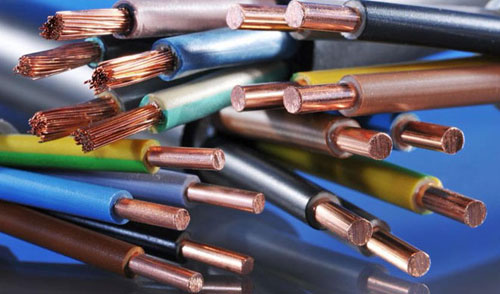
If you mount wires with a large cross-sectional area, then safe use is ensured. But from a financial point of view, there will be cost overruns.The correct choice of wire section is the key to long-term safe operation and rational use of financial resources.
A separate chapter in the PUE is devoted to the correct selection of the conductor: “Chapter 1.3. The choice of conductors for heating, economic current density and corona conditions.
The cable cross-section is calculated by power and current. Let's look at examples. To determine what wire size is needed for 5 kW, you will need to use the PUE tables ("Rules for the installation of electrical installations"). This handbook is a regulatory document. It indicates that the choice of cable section is made according to 4 criteria:
- Supply voltage (single phase or three phase).
- conductor material.
- Load current, measured in amperes (BUT), or power - in kilowatts (kW).
- Cable location.
There is no value in the PUE 5 kW, so you have to choose the next larger value - 5.5 kW. For installation in an apartment today, you need use copper wire. In most cases, installation takes place over the air, so a cross section of 2.5 mm² is suitable from the reference tables. In this case, the maximum allowable current load will be 25 A.
The above reference also regulates the current for which the introductory machine is designed (VA). According to "Rules for the installation of electrical installations“, at a load of 5.5 kW, the VA current should be 25 A. The document states that the rated current of the wire that fits the house or apartment should be one step higher than that of VA. In this case, after 25 A there is 35 A. The last value must be taken as the calculated one. A current of 35 A corresponds to a cross section of 4 mm² and a power of 7.7 kW. So, the choice of the copper wire cross-section by power is completed: 4 mm².
To find out what wire size is needed for 10 kWLet's use the guide again. If we consider the case for open wiring, then we need to decide on the cable material and the supply voltage.
For example, for an aluminum wire and a voltage of 220 V, the nearest large power will be 13 kW, the corresponding section is 10 mm²; for 380 V, the power will be 12 kW, and the cross section will be 4 mm².
Choose by power
Before choosing a cable cross-section for power, it is necessary to calculate its total value, draw up a list of electrical appliances located in the territory to which the cable is laid. On each of the devices, the power must be indicated, the corresponding units of measurement will be written next to it: W or kW (1 kW = 1000 W). Then you need to add up the power of all equipment and get the total.
If a cable is selected to connect one device, then only information about its power consumption is sufficient. You can select the wire cross-sections for power in the tables of the PUE.
Table 1. Selection of the wire cross-section by power for a cable with copper conductors
| Conductor cross section, mm² | For cable with copper conductors | |||
| Voltage 220 V | Voltage 380 V | |||
| Current, A | power, kWt | Current, A | power, kWt | |
| 1,5 | 19 | 4,1 | 16 | 10,5 |
| 2,5 | 27 | 5,9 | 25 | 16,5 |
| 4 | 38 | 8,3 | 30 | 19,8 |
| 6 | 46 | 10,1 | 40 | 26,4 |
| 10 | 70 | 15,4 | 50 | 33 |
| 16 | 85 | 18,7 | 75 | 49,5 |
| 25 | 115 | 25,3 | 90 | 59,4 |
| 35 | 135 | 29,7 | 115 | 75.9 |
| 50 | 175 | 38.5 | 145 | 95,7 |
| 70 | 215 | 47,3 | 180 | 118,8 |
| 95 | 260 | 57,2 | 220 | 145,2 |
| 120 | 300 | 66 | 260 | 171,6 |
Table 2. Selection of the wire cross-section by power for a cable with aluminum conductors
| Conductor cross section, mm² | For cable with aluminum conductors | |||
| Voltage 220 V | Voltage 380 V | |||
| Current, A | power, kWt | Current, A | power, kWt | |
| 2,5 | 20 | 4,4 | 19 | 12,5 |
| 4 | 28 | 6,1 | 23 | 15,1 |
| 6 | 36 | 7,9 | 30 | 19,8 |
| 10 | 50 | 11,0 | 39 | 25,7 |
| 16 | 60 | 13,2 | 55 | 36,3 |
| 25 | 85 | 18,7 | 70 | 46,2 |
| 35 | 100 | 22,0 | 85 | 56,1 |
| 50 | 135 | 29,7 | 110 | 72,6 |
| 70 | 165 | 36,3 | 140 | 92,4 |
| 95 | 200 | 44,0 | 170 | 112,2 |
| 120 | 230 | 50,6 | 200 | 132,2 |
In addition, you need to know the mains voltage: three-phase corresponds to 380 V, and single-phase - 220 V.
The PUE provides information for both aluminum and copper wires. Both have their advantages and disadvantages.Advantages of copper wires:
- high strength;
- elasticity;
- resistance to oxidation;
- electrical conductivity is greater than that of aluminum.
The disadvantage of copper conductors - high price. In Soviet houses, aluminum wiring was used during construction. Therefore, if a partial replacement occurs, it is advisable to install aluminum wires. The only exceptions are those cases when, instead of all the old wiring (to switchboard) a new one is installed. Then it makes sense to use copper. It is unacceptable that copper and aluminum come into direct contact, as this leads to oxidation. Therefore, a third metal is used to connect them.
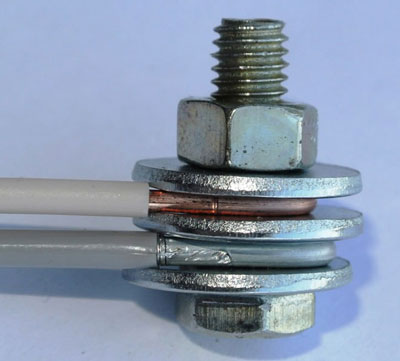
You can independently calculate the wire cross-section by power for a three-phase circuit. To do this, use the formula: I=P/(U*1.73), where P - Power, W; U - voltage, V; I - current, A. Then, from the reference table, the cable cross-section is selected depending on the calculated current. If there is no required value, then the nearest one is selected, which exceeds the calculated one.
How to calculate by current
The amount of current passing through the conductor depends on the length, width, resistivity of the latter and on temperature. When heated, the electric current decreases. Reference information is indicated for room temperature (18°С). To select the cable section for current, use the PUE tables (PUE-7 p.1.3.10-1.3.11 PERMISSIBLE CONTINUOUS CURRENTS FOR WIRES, CORDS AND CABLES WITH RUBBER OR PLASTIC INSULATION).
Table 3 Electric current for copper wires and cords with rubber and PVC insulation
| Conductor cross-section area, mm² | Current, A, for wires laid | |||||
| open | in one pipe | |||||
| two single-core | three single-core | four single-core | one two-core | one three-core | ||
| 0,5 | 11 | - | - | - | - | - |
| 0,75 | 15 | - | - | - | - | - |
| 1 | 17 | 16 | 15 | 14 | 15 | 14 |
| 1,2 | 20 | 18 | 16 | 15 | 16 | 14,5 |
| 1,5 | 23 | 19 | 17 | 16 | 18 | 15 |
| 2 | 26 | 24 | 22 | 20 | 23 | 19 |
| 2,5 | 30 | 27 | 25 | 25 | 25 | 21 |
| 3 | 34 | 32 | 28 | 26 | 28 | 24 |
| 4 | 41 | 38 | 35 | 30 | 32 | 27 |
| 5 | 46 | 42 | 39 | 34 | 37 | 31 |
| 6 | 50 | 46 | 42 | 40 | 40 | 34 |
| 8 | 62 | 54 | 51 | 46 | 48 | 43 |
| 10 | 80 | 70 | 60 | 50 | 55 | 50 |
| 16 | 100 | 85 | 80 | 75 | 80 | 70 |
| 25 | 140 | 115 | 100 | 90 | 100 | 85 |
| 35 | 170 | 135 | 125 | 115 | 125 | 100 |
| 50 | 215 | 185 | 170 | 150 | 160 | 135 |
| 70 | 270 | 225 | 210 | 185 | 195 | 175 |
| 95 | 330 | 275 | 255 | 225 | 245 | 215 |
| 120 | 385 | 315 | 290 | 260 | 295 | 250 |
| 150 | 440 | 360 | 330 | - | - | - |
| 185 | 510 | - | - | - | - | - |
| 240 | 605 | - | - | - | - | - |
| 300 | 695 | - | - | - | - | - |
| 400 | 830 | - | - | - | - | - |
A table is used to calculate aluminum wires.
Table 4 Electric current for aluminum wires and cords with rubber and PVC insulation
| Conductor section area, mm² | Current, A, for wires laid | |||||
| open | in one pipe | |||||
| two single-core | three single-core | four single-core | one two-core | one three-core | ||
| 2 | 21 | 19 | 18 | 15 | 17 | 14 |
| 2,5 | 24 | 20 | 19 | 19 | 19 | 16 |
| 3 | 27 | 24 | 22 | 21 | 22 | 18 |
| 4 | 32 | 28 | 28 | 23 | 25 | 21 |
| 5 | 36 | 32 | 30 | 27 | 28 | 24 |
| 6 | 39 | 36 | 32 | 30 | 31 | 26 |
| 8 | 46 | 43 | 40 | 37 | 38 | 32 |
| 10 | 60 | 50 | 47 | 39 | 42 | 38 |
| 16 | 75 | 60 | 60 | 55 | 60 | 55 |
| 25 | 105 | 85 | 80 | 70 | 75 | 65 |
| 35 | 130 | 100 | 95 | 85 | 95 | 75 |
| 50 | 165 | 140 | 130 | 120 | 125 | 105 |
| 70 | 210 | 175 | 165 | 140 | 150 | 135 |
| 95 | 255 | 215 | 200 | 175 | 190 | 165 |
| 120 | 295 | 245 | 220 | 200 | 230 | 190 |
| 150 | 340 | 275 | 255 | - | - | - |
| 185 | 390 | - | - | - | - | - |
| 240 | 465 | - | - | - | - | - |
| 300 | 535 | - | - | - | - | - |
| 400 | 645 | - | - | - | - | - |
In addition to electric current, you will need to select the conductor material and voltage.
For an approximate calculation of the cable cross-section by current, it must be divided by 10. If the table does not contain the resulting cross-section, then it is necessary to take the next larger value. This rule is only suitable for cases where the maximum allowable current for copper wires does not exceed 40 A. For the range from 40 to 80 A, the current must be divided by 8. If aluminum cables are installed, then it must be divided by 6. This is because for ensuring the same loads, the thickness of the aluminum conductor is greater than that of copper.
Calculation of the cable cross-section by power and length
The length of the cable influences the voltage loss. Thus, at the end of the conductor, the voltage may decrease and be insufficient for the operation of the electrical appliance. For household electrical networks, these losses can be neglected. It will be enough to take a cable 10-15 cm longer. This reserve will be spent on switching and connection. If the ends of the wire are connected to the shield, then the spare length should be even longer, since they will be connected circuit breakers.
When laying cables over long distances, you have to take into account voltage drop. Each conductor is characterized by electrical resistance. This setting is affected by:
- Wire length, unit of measurement - m. As it increases, losses increase.
- Cross-sectional area, measured in mm². As it increases, the voltage drop decreases.
- Material resistivity (reference value). Shows the resistance of a wire whose dimensions are 1 square millimeter by 1 meter.
The voltage drop is numerically equal to the product of resistance and current. It is permissible that the specified value does not exceed 5%. Otherwise, you need to take a larger cable. Algorithm for calculating the wire cross-section according to the maximum power and length:
- Depending on power P, voltage U and coefficient cosph we find the current by the formula: I=P/(U*cosf). For electrical networks that are used in everyday life, cosf = 1. In industry, cosf is calculated as the ratio of active power to apparent power. The latter consists of active and reactive power.
- Using the PUE tables, the current cross section of the wire is determined.
- We calculate the resistance of the conductor using the formula: Ro=ρ*l/S, where ρ is the resistivity of the material, l is the length of the conductor, S is the cross-sectional area. It is necessary to take into account the current, the fact that the current flows through the cable not only in one direction, but also back. So the total resistance is: R \u003d Ro * 2.
- We find the voltage drop from the ratio: ∆U=I*R.
- Determine the voltage drop in percent: ΔU/U. If the value obtained exceeds 5%, then we select the nearest larger cross-section of the conductor from the reference book.
Open and closed wiring
Depending on the placement, the wiring is divided into 2 types:
- closed;
- open.
Today, hidden wiring is being installed in apartments.Special recesses are created in the walls and ceilings, designed to accommodate the cable. After installing the conductors, the recesses are plastered. Copper wires are used. Everything is planned in advance, because over time, to build up electrical wiring or replace elements, you will have to dismantle the finish. For hidden finishes, wires and cables that have a flat shape are more often used.
With open laying, the wires are installed along the surface of the room. Advantages are given to flexible conductors, which have a round shape. They are easy to install in cable channels and pass through the corrugation. When calculating the load on the cable, they take into account the method of laying the wiring.
Similar articles:
